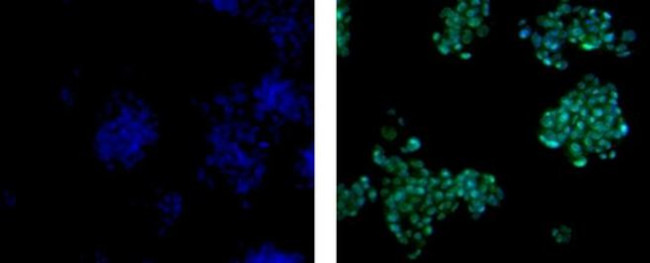Search Thermo Fisher Scientific
Invitrogen
SOX9 Monoclonal Antibody (GMPR9), Alexa Fluor™ 488, eBioscience™
FIGURE: 1 / 1
SOX9 Antibody (53-9765-80) in ICC/IF

Product Details
53-9765-80
Species Reactivity
Host/Isotype
Recommended Isotype Control
Class
Type
Clone
Conjugate
Excitation/Emission Max
Form
Concentration
Purification
Storage buffer
Contains
Storage conditions
Shipping conditions
RRID
Product Specific Information
Description: This GMPR9 monoclonal antibody reacts with human and mouse Sox9, a member of the Sry HMG-box (Sox) gene family of transcription factors. Like Sry, Sox9 contains a high mobility group (HMG-box) DNA-binding domain. The Sox9 DNA-binding domain recognizes the sequence AGAACAATGG, and when bound to co-factors, functions to bend the DNA. This structural change is thought to be important for chromatin remodeling and the initiation of more broad transcriptional regulation of multiple genes. Sox9 is expressed in multiple tissue types during development and its activation of downstream targets is determined by interaction with tissue-specific co-factors. During development, Sox9 expression is important for cartilage formation (mesenchymal to chondrocyte), sex determination (testes formation), neural crest formation and retinal development. Sox9 plays a role in the differentiation of multiple cell types including glial, hair, cardiac, melanocytes, pancreatic, prostate, and intestinal epithelium. Sox9 regulates expression of the following family member genes sox5, sox6, and sox10, in addition to collagen type 2 alpha, collagen 9A1, CEACAM1, and snail2. Sox9 dysregulation is involved in craniofacial defects, cleft palate, sex reversal, and some types of cancer (melanoma, lung adenocarcinoma, and breast cancer). Sox9 has also been shown to be expressed in adult stem cells in the liver, pancreas and intestine.
Applications Reported: This GMPR9 antibody has been reported for use in immunohistochemical staining of formalin-fixed paraffin embedded tissue sections, microscopy, and immunocytochemistry.
Applications Tested: This GMPR9 antibody has been tested by immunocytochemistry of fixed and permeabilized cells and can be used at less than or equal to 10 µg/mL. It is recommended that the antibody be carefully titrated for optimal performance in the assay of interest.
Excitation: 488 nm; Emission: 519 nm; Laser: Blue Laser.
Filtration: 0.2 µm post-manufacturing filtered.
Target Information
SOX9 has a role in sex determination and differentiation of Sertoli cells. It is involved in chondrogenesis and regulates the expression of other genes involved in chondrogenesis by acting as a transcription factor for these genes. Translocation of this gene can cause campomelic dysplasia. SOX9 is involved in the formation of testes from the indifferent fetal gonads. It is a major molecular component of the neuron-glia switch in developing spinal cord. During normal development, SOX9 allows the prostate epithelium to outgrow into the mesenchyme and then provides basal cell support for development and maintenance of the luminal epithelium. These functions of SOX9 are subverted in prostate cancer to support tumor growth and invasion. SOX9 may direct the formation of neural crest precursors and the development of a range of neural crest derivative. It has a transcriptional regulation in melanin production in cells. Northern blot analysis shows its expression on adult testis, adult heart, and fetal brain.
For Research Use Only. Not for use in diagnostic procedures. Not for resale without express authorization.
References (0)
Bioinformatics
Protein Aliases: mSox9; SOX 9; SRY (sex determining region Y)-box9; SRY (sex-determining region Y)-box 9 protein; SRY box 9; SRY-Box 9 ; SRY-box containing gene 9; SRY-related HMG-box, gene 9; Transcription factor SOX-9
Gene Aliases: 2010306G03Rik; AV220920; CMD1; CMPD1; mKIAA4243; Sox-9; SOX9; SRA1; SRXX2; SRXY10
UniProt ID: (Human) P48436, (Mouse) Q04887
Entrez Gene ID: (Human) 6662, (Mouse) 20682

Performance Guarantee
If an Invitrogen™ antibody doesn't perform as described on our website or datasheet,we'll replace the product at no cost to you, or provide you with a credit for a future purchase.*
Learn more
We're here to help
Get expert recommendations for common problems or connect directly with an on staff expert for technical assistance related to applications, equipment and general product use.
Contact tech support

